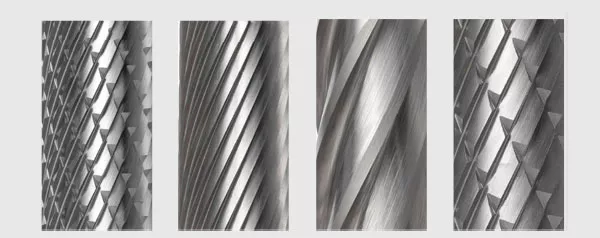
Learn about solid tungsten carbide burrs with each style from 3 aspects
Introduction
Good quality tungsten carbide rotary files, made of high-quality tungsten carbide materials, also known as tungsten steel rotary files, are usually used in conjunction with high-speed electric grinders or pneumatic tools and can be used for various job requirements, such as machining cast iron, cast steel, carbon Plain steel, alloy steel, stainless steel, hardened steel, copper and aluminum, etc.
International general standard shape classification
Generally, the rotary file can be divided into the following 19 shapes. The most commonly used are cylindrical, spherical, flame head shape, etc. In China, letters such as A, B, and C are used to directly represent each shape. Foreign countries usually use the letters ZYA, KUD, and RBF abbreviations.

Blade tooth classification
Generally, single-edged tooth-shaped rotary files are more suitable for processing operations such as soft non-ferrous metals, plastics, soft high-stretch steels, or hardwoods, while cross-shaped toothed files are more suitable for producing higher cutting performance on hard materials. Such as cast iron, cast steel, glass fiber plastic materials for grinding work.
For each shape of the rotary file, the tooth profile of the blade teeth can be selected according to the specific operational requirements. Among them, each tooth profile is suitable for:
1. Cross tooth pattern: This kind of tooth pattern is suitable for all kinds of metal materials. It has less vibration during processing and is easy to manipulate.
2. Dense tooth pattern: suitable for finishing and other processing requiring high surface quality, such as tempered steel below HRC66.
3. Diamond tooth pattern: This tooth shape is suitable for processing high-alloy steel, stainless steel, and cast iron, effectively avoiding the adverse phenomena caused by cutting and crushing during operation.
4. Middle tooth pattern: suitable for all kinds of steel. The surface processing quality of this tooth profile is excellent, and the processing efficiency is relatively high.
5. Coarse tooth pattern: soft materials are recommended, such as bronze, tin, zinc pure copper, and other materials that are easy to process.
6. Aluminum tooth pattern: It is suitable for soft metals such as aluminum alloy and brass. Because the tooth spacing is relatively wide, it is conducive to rapid removal and cutting.

Rotary file size selection:
The size of the rotary file is mainly based on the head diameter Dc and the handle diameter D2. The head blade diameter L2 and the total length L1 can be selected according to the specific operation requirements!
Standard type rotary file: The shank diameter (D2) mainly has 3mm, 6mm, and 6.35mm, and the shank length is a common specification for operations.
Extended shank rotary file: This kind of shank length can be selected according to special working conditions to extend the shank, generally, 75mm, 100mm, 150mm, and 300mm are the most commonly used. Very suitable for processing hard-to-reach or deep areas. The longer the handle of the extended handle, the better, because too long will cause a certain vibration during the grinding operation and affect the operation effect.
Miniature rotary file: Therefore, the diameter of the head of this kind of rotary file is small, and the diameter of the shank is generally 3mm. Because of its high degree of concentricity, it is suitable for trimming precision workstation components.

Conclusion
Understanding the shape, tooth, and size of cemented carbide rotary files for shaping can help us use them correctly and reasonably.